Understanding Employee Motivation: Factors and Strategies Explored
VerifiedAdded on 2023/06/12
|11
|2362
|84
Essay
AI Summary
This essay explores the multifaceted reasons behind employee motivation, highlighting the fulfillment of basic human needs as a primary driver. It delves into various factors that influence an individual's decision to work, including intrinsic and extrinsic motivations, and examines motivational theories such as Maslow's hierarchy of needs, which outlines the different stages of human requirements from basic physiological needs to self-actualization. The essay discusses the significance of salary, a positive working environment, and effective promotion strategies in motivating employees. It also addresses positive outcomes such as development opportunities and encouragement, alongside negative factors like unsecure work environments and work pressure. The study concludes by suggesting strategies to mitigate negative factors and enhance the overall employee experience, emphasizing the importance of safety measures and expert management in fostering a motivated workforce. This resource is available on Desklib, offering students access to similar assignments and study tools.
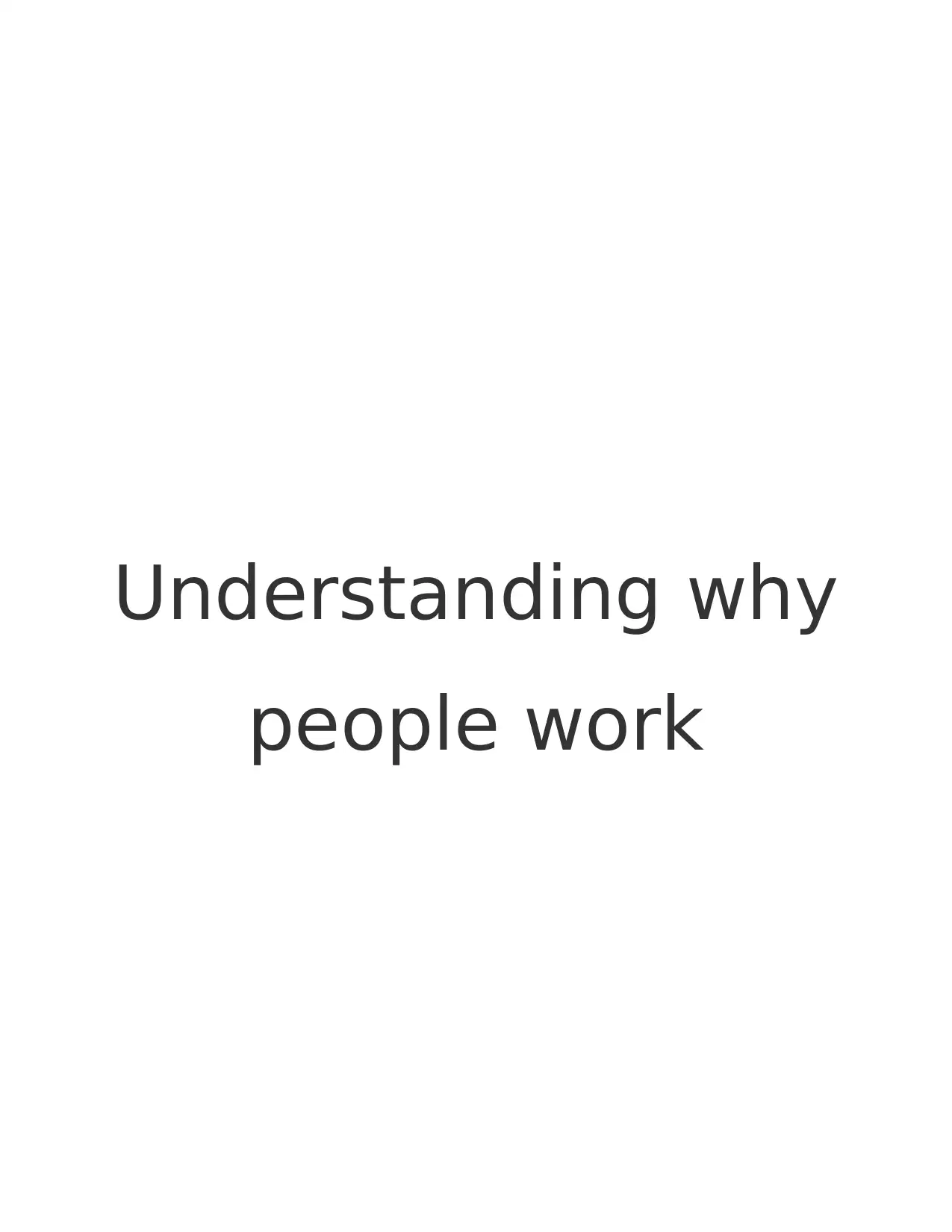
Understanding why
people work
people work
Paraphrase This Document
Need a fresh take? Get an instant paraphrase of this document with our AI Paraphraser
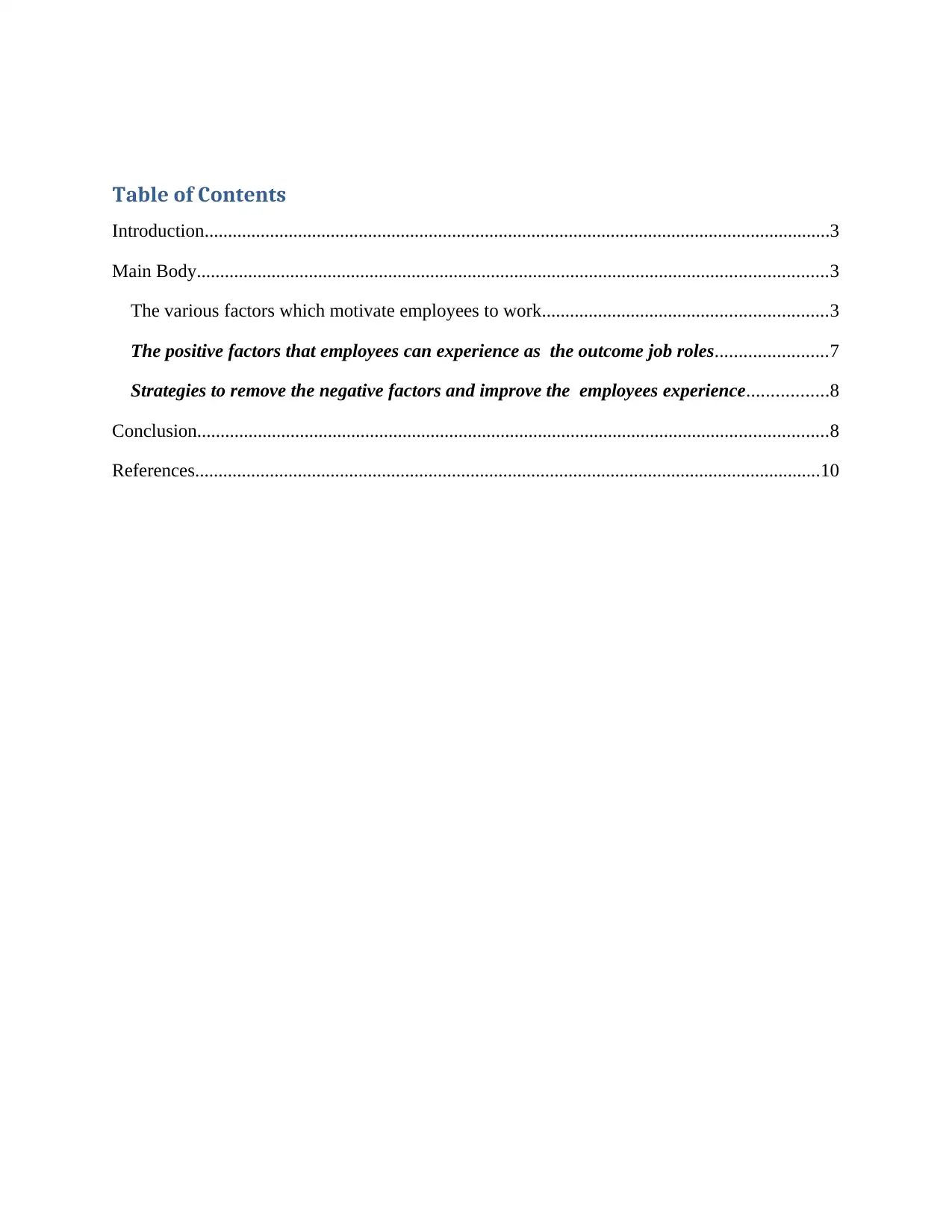
Table of Contents
Introduction......................................................................................................................................3
Main Body.......................................................................................................................................3
The various factors which motivate employees to work.............................................................3
The positive factors that employees can experience as the outcome job roles........................7
Strategies to remove the negative factors and improve the employees experience.................8
Conclusion.......................................................................................................................................8
References......................................................................................................................................10
Introduction......................................................................................................................................3
Main Body.......................................................................................................................................3
The various factors which motivate employees to work.............................................................3
The positive factors that employees can experience as the outcome job roles........................7
Strategies to remove the negative factors and improve the employees experience.................8
Conclusion.......................................................................................................................................8
References......................................................................................................................................10
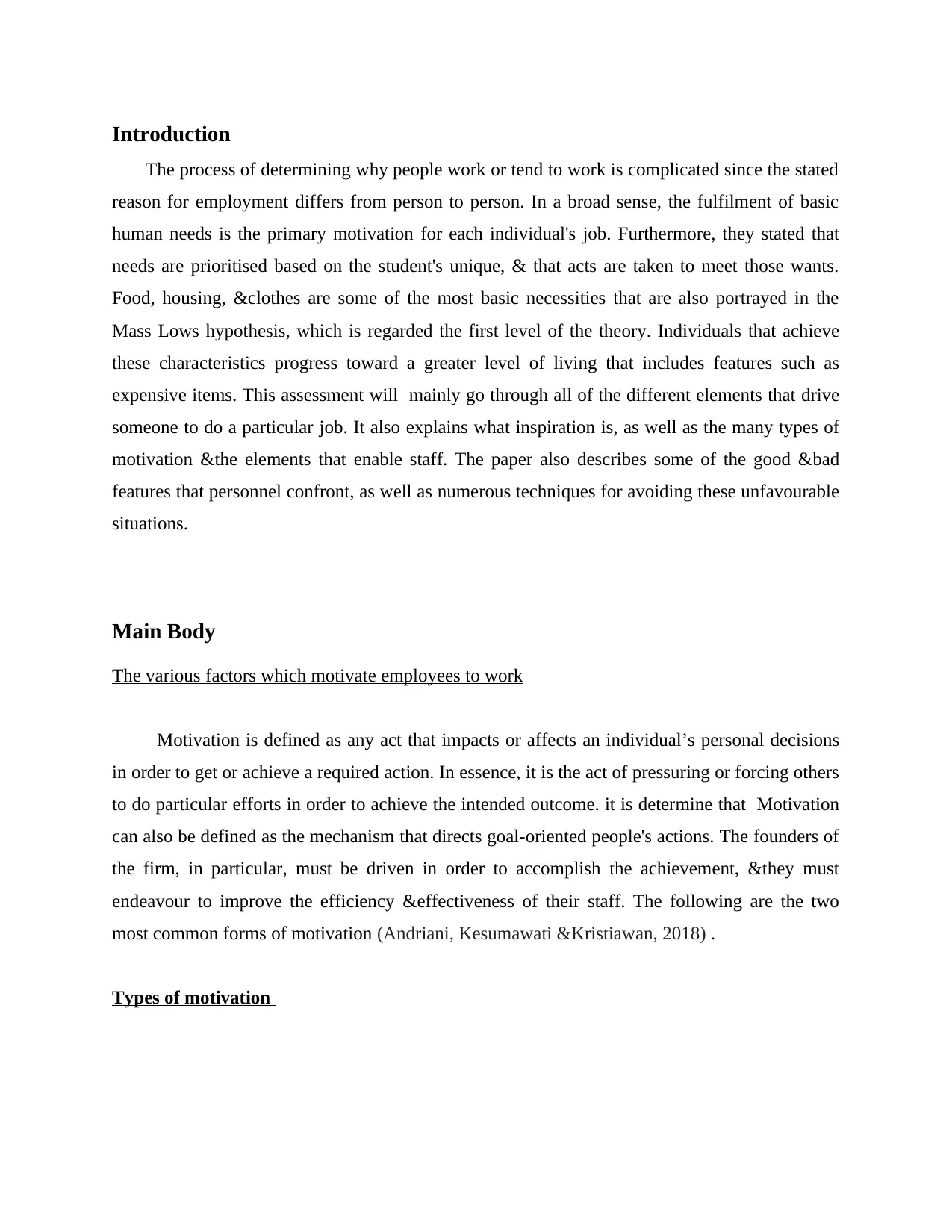
Introduction
The process of determining why people work or tend to work is complicated since the stated
reason for employment differs from person to person. In a broad sense, the fulfilment of basic
human needs is the primary motivation for each individual's job. Furthermore, they stated that
needs are prioritised based on the student's unique, & that acts are taken to meet those wants.
Food, housing, &clothes are some of the most basic necessities that are also portrayed in the
Mass Lows hypothesis, which is regarded the first level of the theory. Individuals that achieve
these characteristics progress toward a greater level of living that includes features such as
expensive items. This assessment will mainly go through all of the different elements that drive
someone to do a particular job. It also explains what inspiration is, as well as the many types of
motivation &the elements that enable staff. The paper also describes some of the good &bad
features that personnel confront, as well as numerous techniques for avoiding these unfavourable
situations.
Main Body
The various factors which motivate employees to work
Motivation is defined as any act that impacts or affects an individual’s personal decisions
in order to get or achieve a required action. In essence, it is the act of pressuring or forcing others
to do particular efforts in order to achieve the intended outcome. it is determine that Motivation
can also be defined as the mechanism that directs goal-oriented people's actions. The founders of
the firm, in particular, must be driven in order to accomplish the achievement, &they must
endeavour to improve the efficiency &effectiveness of their staff. The following are the two
most common forms of motivation (Andriani, Kesumawati &Kristiawan, 2018) .
Types of motivation
The process of determining why people work or tend to work is complicated since the stated
reason for employment differs from person to person. In a broad sense, the fulfilment of basic
human needs is the primary motivation for each individual's job. Furthermore, they stated that
needs are prioritised based on the student's unique, & that acts are taken to meet those wants.
Food, housing, &clothes are some of the most basic necessities that are also portrayed in the
Mass Lows hypothesis, which is regarded the first level of the theory. Individuals that achieve
these characteristics progress toward a greater level of living that includes features such as
expensive items. This assessment will mainly go through all of the different elements that drive
someone to do a particular job. It also explains what inspiration is, as well as the many types of
motivation &the elements that enable staff. The paper also describes some of the good &bad
features that personnel confront, as well as numerous techniques for avoiding these unfavourable
situations.
Main Body
The various factors which motivate employees to work
Motivation is defined as any act that impacts or affects an individual’s personal decisions
in order to get or achieve a required action. In essence, it is the act of pressuring or forcing others
to do particular efforts in order to achieve the intended outcome. it is determine that Motivation
can also be defined as the mechanism that directs goal-oriented people's actions. The founders of
the firm, in particular, must be driven in order to accomplish the achievement, &they must
endeavour to improve the efficiency &effectiveness of their staff. The following are the two
most common forms of motivation (Andriani, Kesumawati &Kristiawan, 2018) .
Types of motivation
⊘ This is a preview!⊘
Do you want full access?
Subscribe today to unlock all pages.

Trusted by 1+ million students worldwide
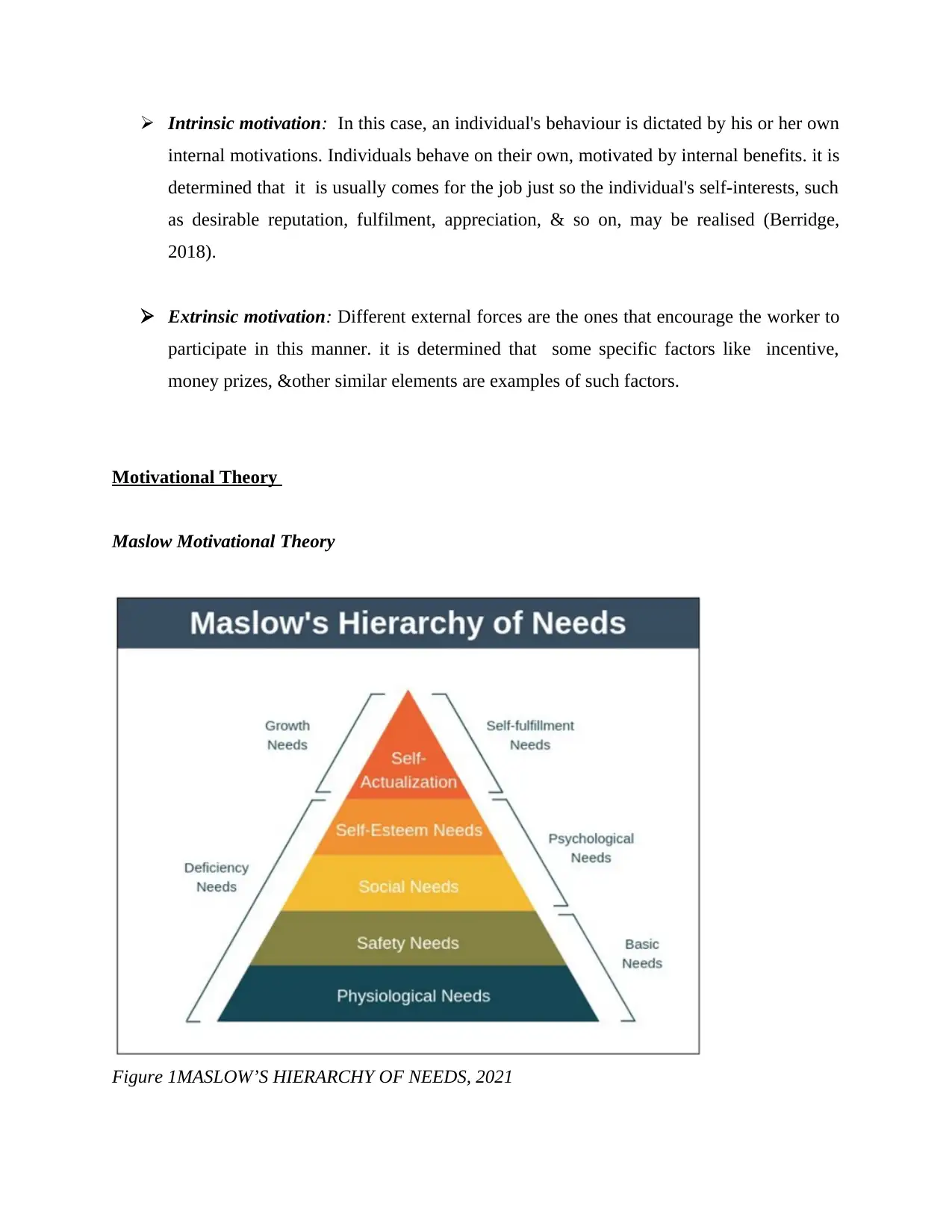
Intrinsic motivation: In this case, an individual's behaviour is dictated by his or her own
internal motivations. Individuals behave on their own, motivated by internal benefits. it is
determined that it is usually comes for the job just so the individual's self-interests, such
as desirable reputation, fulfilment, appreciation, & so on, may be realised (Berridge,
2018).
Extrinsic motivation: Different external forces are the ones that encourage the worker to
participate in this manner. it is determined that some specific factors like incentive,
money prizes, &other similar elements are examples of such factors.
Motivational Theory
Maslow Motivational Theory
Figure 1MASLOW’S HIERARCHY OF NEEDS, 2021
internal motivations. Individuals behave on their own, motivated by internal benefits. it is
determined that it is usually comes for the job just so the individual's self-interests, such
as desirable reputation, fulfilment, appreciation, & so on, may be realised (Berridge,
2018).
Extrinsic motivation: Different external forces are the ones that encourage the worker to
participate in this manner. it is determined that some specific factors like incentive,
money prizes, &other similar elements are examples of such factors.
Motivational Theory
Maslow Motivational Theory
Figure 1MASLOW’S HIERARCHY OF NEEDS, 2021
Paraphrase This Document
Need a fresh take? Get an instant paraphrase of this document with our AI Paraphraser
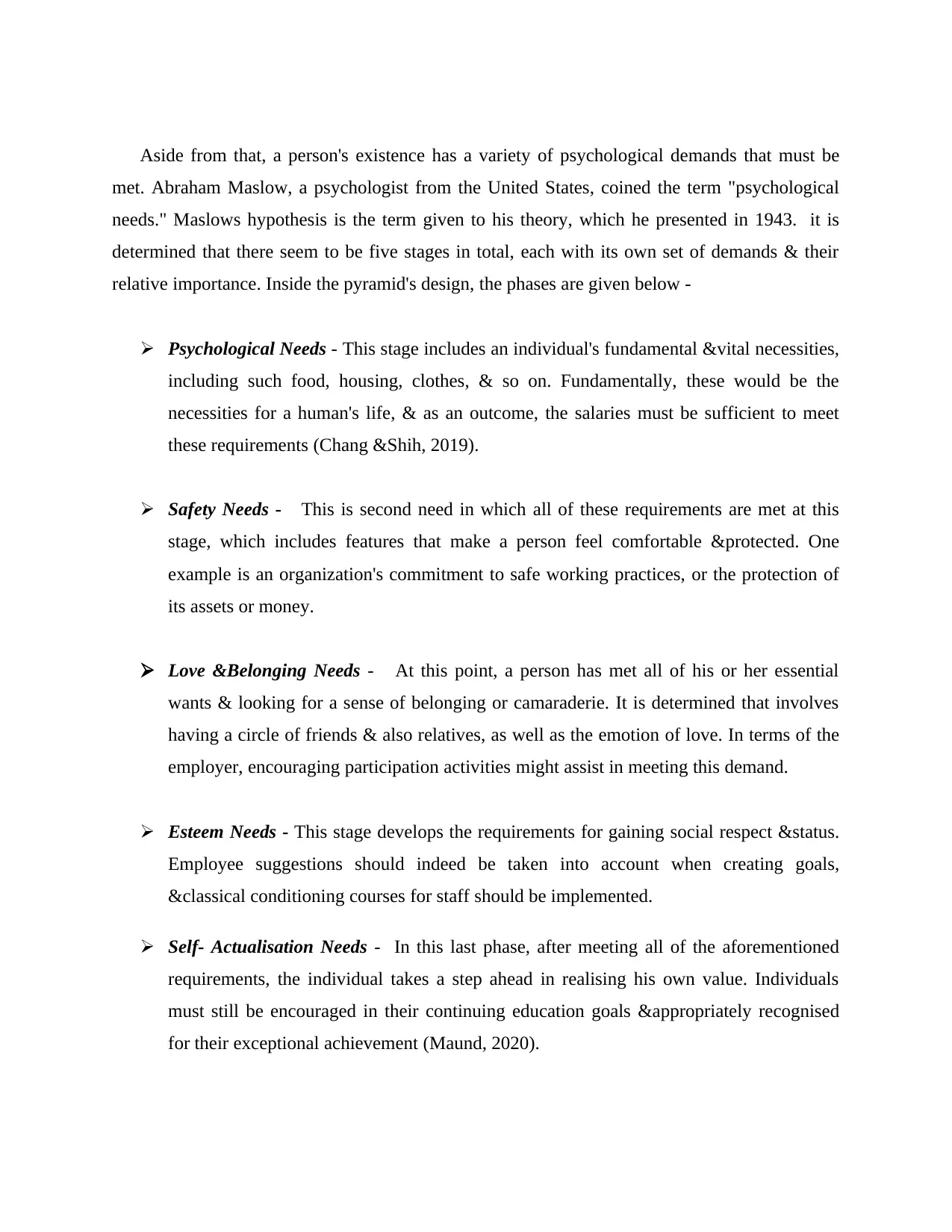
Aside from that, a person's existence has a variety of psychological demands that must be
met. Abraham Maslow, a psychologist from the United States, coined the term "psychological
needs." Maslows hypothesis is the term given to his theory, which he presented in 1943. it is
determined that there seem to be five stages in total, each with its own set of demands & their
relative importance. Inside the pyramid's design, the phases are given below -
Psychological Needs - This stage includes an individual's fundamental &vital necessities,
including such food, housing, clothes, & so on. Fundamentally, these would be the
necessities for a human's life, & as an outcome, the salaries must be sufficient to meet
these requirements (Chang &Shih, 2019).
Safety Needs - This is second need in which all of these requirements are met at this
stage, which includes features that make a person feel comfortable &protected. One
example is an organization's commitment to safe working practices, or the protection of
its assets or money.
Love &Belonging Needs - At this point, a person has met all of his or her essential
wants & looking for a sense of belonging or camaraderie. It is determined that involves
having a circle of friends & also relatives, as well as the emotion of love. In terms of the
employer, encouraging participation activities might assist in meeting this demand.
Esteem Needs - This stage develops the requirements for gaining social respect &status.
Employee suggestions should indeed be taken into account when creating goals,
&classical conditioning courses for staff should be implemented.
Self- Actualisation Needs - In this last phase, after meeting all of the aforementioned
requirements, the individual takes a step ahead in realising his own value. Individuals
must still be encouraged in their continuing education goals &appropriately recognised
for their exceptional achievement (Maund, 2020).
met. Abraham Maslow, a psychologist from the United States, coined the term "psychological
needs." Maslows hypothesis is the term given to his theory, which he presented in 1943. it is
determined that there seem to be five stages in total, each with its own set of demands & their
relative importance. Inside the pyramid's design, the phases are given below -
Psychological Needs - This stage includes an individual's fundamental &vital necessities,
including such food, housing, clothes, & so on. Fundamentally, these would be the
necessities for a human's life, & as an outcome, the salaries must be sufficient to meet
these requirements (Chang &Shih, 2019).
Safety Needs - This is second need in which all of these requirements are met at this
stage, which includes features that make a person feel comfortable &protected. One
example is an organization's commitment to safe working practices, or the protection of
its assets or money.
Love &Belonging Needs - At this point, a person has met all of his or her essential
wants & looking for a sense of belonging or camaraderie. It is determined that involves
having a circle of friends & also relatives, as well as the emotion of love. In terms of the
employer, encouraging participation activities might assist in meeting this demand.
Esteem Needs - This stage develops the requirements for gaining social respect &status.
Employee suggestions should indeed be taken into account when creating goals,
&classical conditioning courses for staff should be implemented.
Self- Actualisation Needs - In this last phase, after meeting all of the aforementioned
requirements, the individual takes a step ahead in realising his own value. Individuals
must still be encouraged in their continuing education goals &appropriately recognised
for their exceptional achievement (Maund, 2020).
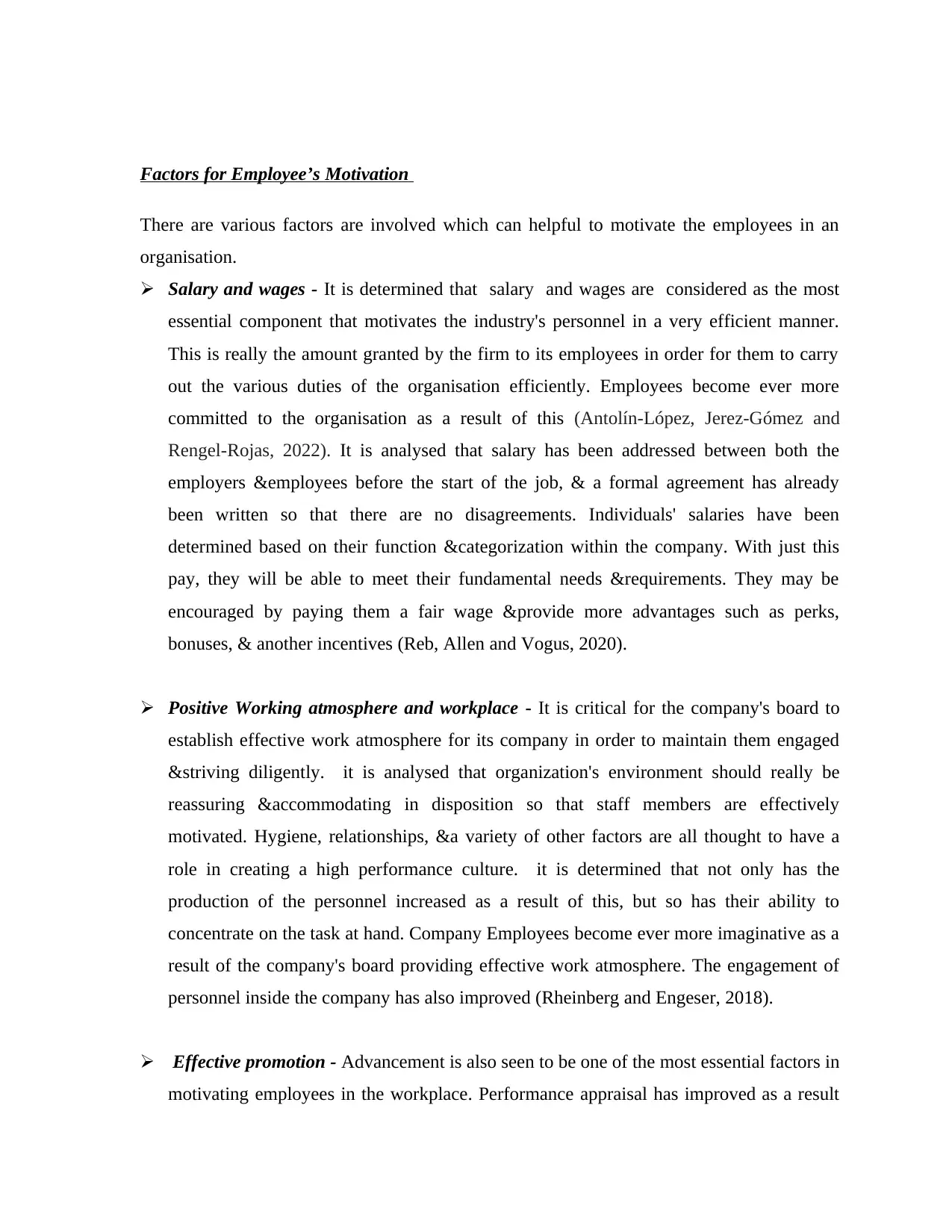
Factors for Employee’s Motivation
There are various factors are involved which can helpful to motivate the employees in an
organisation.
Salary and wages - It is determined that salary and wages are considered as the most
essential component that motivates the industry's personnel in a very efficient manner.
This is really the amount granted by the firm to its employees in order for them to carry
out the various duties of the organisation efficiently. Employees become ever more
committed to the organisation as a result of this (Antolín-López, Jerez-Gómez and
Rengel-Rojas, 2022). It is analysed that salary has been addressed between both the
employers &employees before the start of the job, & a formal agreement has already
been written so that there are no disagreements. Individuals' salaries have been
determined based on their function &categorization within the company. With just this
pay, they will be able to meet their fundamental needs &requirements. They may be
encouraged by paying them a fair wage &provide more advantages such as perks,
bonuses, & another incentives (Reb, Allen and Vogus, 2020).
Positive Working atmosphere and workplace - It is critical for the company's board to
establish effective work atmosphere for its company in order to maintain them engaged
&striving diligently. it is analysed that organization's environment should really be
reassuring &accommodating in disposition so that staff members are effectively
motivated. Hygiene, relationships, &a variety of other factors are all thought to have a
role in creating a high performance culture. it is determined that not only has the
production of the personnel increased as a result of this, but so has their ability to
concentrate on the task at hand. Company Employees become ever more imaginative as a
result of the company's board providing effective work atmosphere. The engagement of
personnel inside the company has also improved (Rheinberg and Engeser, 2018).
Effective promotion - Advancement is also seen to be one of the most essential factors in
motivating employees in the workplace. Performance appraisal has improved as a result
There are various factors are involved which can helpful to motivate the employees in an
organisation.
Salary and wages - It is determined that salary and wages are considered as the most
essential component that motivates the industry's personnel in a very efficient manner.
This is really the amount granted by the firm to its employees in order for them to carry
out the various duties of the organisation efficiently. Employees become ever more
committed to the organisation as a result of this (Antolín-López, Jerez-Gómez and
Rengel-Rojas, 2022). It is analysed that salary has been addressed between both the
employers &employees before the start of the job, & a formal agreement has already
been written so that there are no disagreements. Individuals' salaries have been
determined based on their function &categorization within the company. With just this
pay, they will be able to meet their fundamental needs &requirements. They may be
encouraged by paying them a fair wage &provide more advantages such as perks,
bonuses, & another incentives (Reb, Allen and Vogus, 2020).
Positive Working atmosphere and workplace - It is critical for the company's board to
establish effective work atmosphere for its company in order to maintain them engaged
&striving diligently. it is analysed that organization's environment should really be
reassuring &accommodating in disposition so that staff members are effectively
motivated. Hygiene, relationships, &a variety of other factors are all thought to have a
role in creating a high performance culture. it is determined that not only has the
production of the personnel increased as a result of this, but so has their ability to
concentrate on the task at hand. Company Employees become ever more imaginative as a
result of the company's board providing effective work atmosphere. The engagement of
personnel inside the company has also improved (Rheinberg and Engeser, 2018).
Effective promotion - Advancement is also seen to be one of the most essential factors in
motivating employees in the workplace. Performance appraisal has improved as a result
⊘ This is a preview!⊘
Do you want full access?
Subscribe today to unlock all pages.

Trusted by 1+ million students worldwide
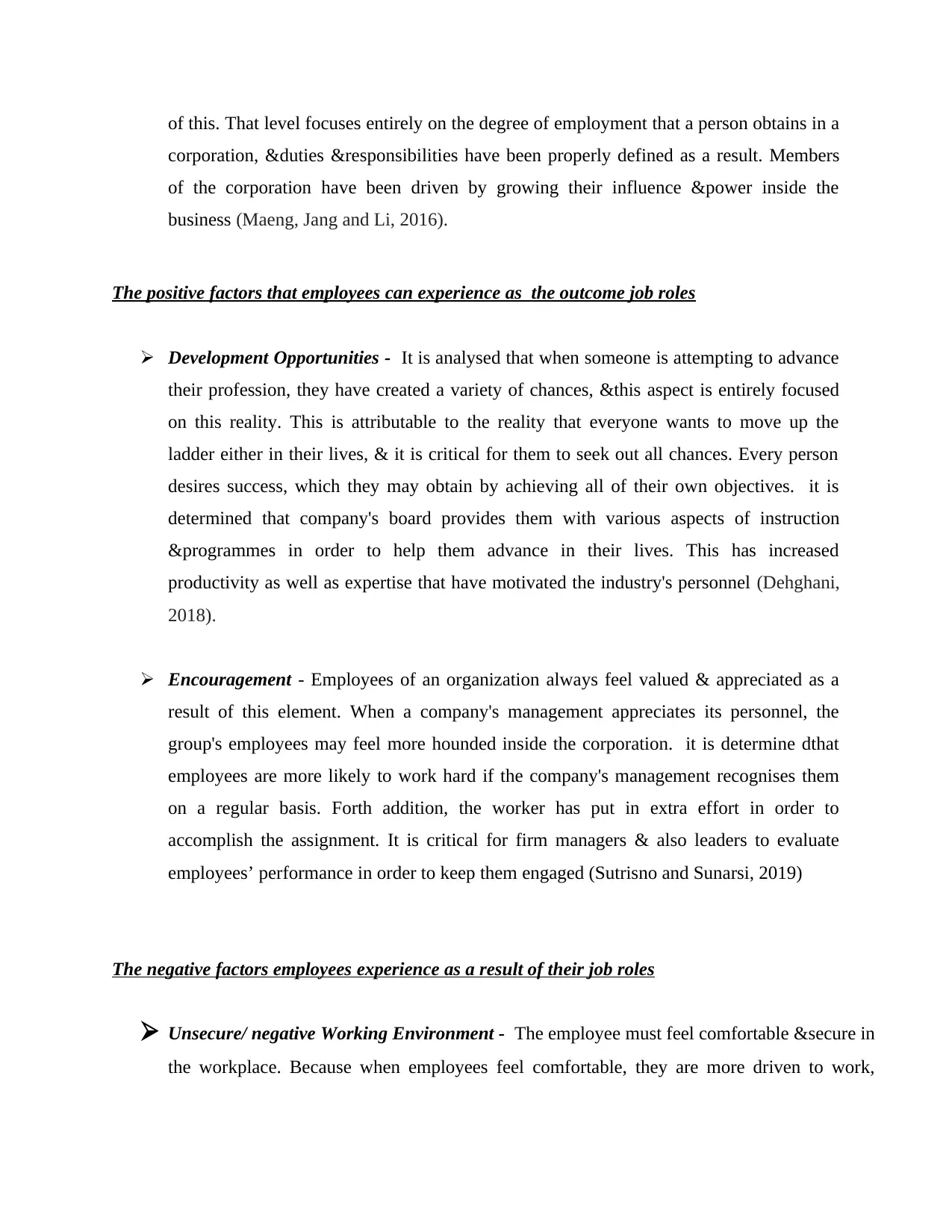
of this. That level focuses entirely on the degree of employment that a person obtains in a
corporation, &duties &responsibilities have been properly defined as a result. Members
of the corporation have been driven by growing their influence &power inside the
business (Maeng, Jang and Li, 2016).
The positive factors that employees can experience as the outcome job roles
Development Opportunities - It is analysed that when someone is attempting to advance
their profession, they have created a variety of chances, &this aspect is entirely focused
on this reality. This is attributable to the reality that everyone wants to move up the
ladder either in their lives, & it is critical for them to seek out all chances. Every person
desires success, which they may obtain by achieving all of their own objectives. it is
determined that company's board provides them with various aspects of instruction
&programmes in order to help them advance in their lives. This has increased
productivity as well as expertise that have motivated the industry's personnel (Dehghani,
2018).
Encouragement - Employees of an organization always feel valued & appreciated as a
result of this element. When a company's management appreciates its personnel, the
group's employees may feel more hounded inside the corporation. it is determine dthat
employees are more likely to work hard if the company's management recognises them
on a regular basis. Forth addition, the worker has put in extra effort in order to
accomplish the assignment. It is critical for firm managers & also leaders to evaluate
employees’ performance in order to keep them engaged (Sutrisno and Sunarsi, 2019)
The negative factors employees experience as a result of their job roles
Unsecure/ negative Working Environment - The employee must feel comfortable &secure in
the workplace. Because when employees feel comfortable, they are more driven to work,
corporation, &duties &responsibilities have been properly defined as a result. Members
of the corporation have been driven by growing their influence &power inside the
business (Maeng, Jang and Li, 2016).
The positive factors that employees can experience as the outcome job roles
Development Opportunities - It is analysed that when someone is attempting to advance
their profession, they have created a variety of chances, &this aspect is entirely focused
on this reality. This is attributable to the reality that everyone wants to move up the
ladder either in their lives, & it is critical for them to seek out all chances. Every person
desires success, which they may obtain by achieving all of their own objectives. it is
determined that company's board provides them with various aspects of instruction
&programmes in order to help them advance in their lives. This has increased
productivity as well as expertise that have motivated the industry's personnel (Dehghani,
2018).
Encouragement - Employees of an organization always feel valued & appreciated as a
result of this element. When a company's management appreciates its personnel, the
group's employees may feel more hounded inside the corporation. it is determine dthat
employees are more likely to work hard if the company's management recognises them
on a regular basis. Forth addition, the worker has put in extra effort in order to
accomplish the assignment. It is critical for firm managers & also leaders to evaluate
employees’ performance in order to keep them engaged (Sutrisno and Sunarsi, 2019)
The negative factors employees experience as a result of their job roles
Unsecure/ negative Working Environment - The employee must feel comfortable &secure in
the workplace. Because when employees feel comfortable, they are more driven to work,
Paraphrase This Document
Need a fresh take? Get an instant paraphrase of this document with our AI Paraphraser
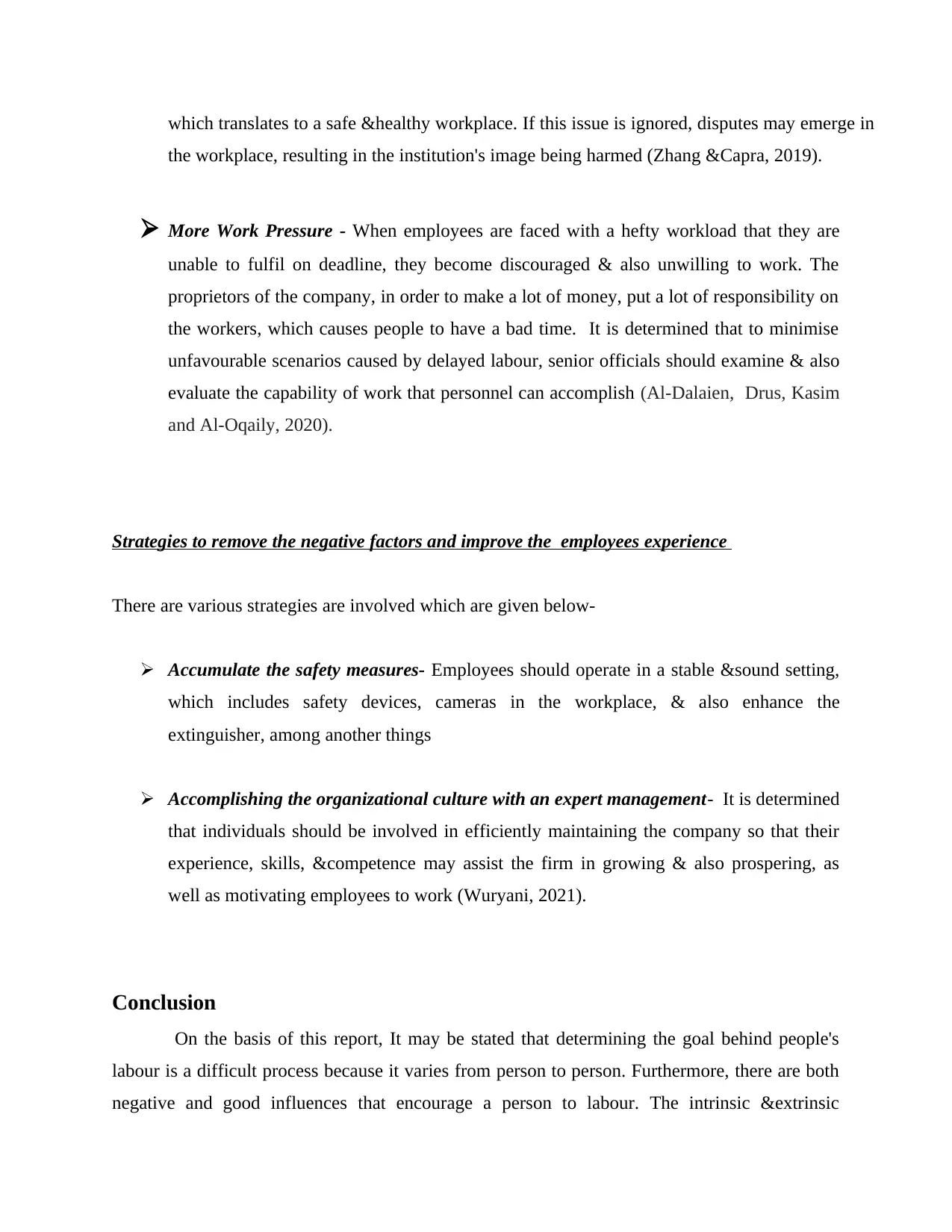
which translates to a safe &healthy workplace. If this issue is ignored, disputes may emerge in
the workplace, resulting in the institution's image being harmed (Zhang &Capra, 2019).
More Work Pressure - When employees are faced with a hefty workload that they are
unable to fulfil on deadline, they become discouraged & also unwilling to work. The
proprietors of the company, in order to make a lot of money, put a lot of responsibility on
the workers, which causes people to have a bad time. It is determined that to minimise
unfavourable scenarios caused by delayed labour, senior officials should examine & also
evaluate the capability of work that personnel can accomplish (Al-Dalaien, Drus, Kasim
and Al-Oqaily, 2020).
Strategies to remove the negative factors and improve the employees experience
There are various strategies are involved which are given below-
Accumulate the safety measures- Employees should operate in a stable &sound setting,
which includes safety devices, cameras in the workplace, & also enhance the
extinguisher, among another things
Accomplishing the organizational culture with an expert management- It is determined
that individuals should be involved in efficiently maintaining the company so that their
experience, skills, &competence may assist the firm in growing & also prospering, as
well as motivating employees to work (Wuryani, 2021).
Conclusion
On the basis of this report, It may be stated that determining the goal behind people's
labour is a difficult process because it varies from person to person. Furthermore, there are both
negative and good influences that encourage a person to labour. The intrinsic &extrinsic
the workplace, resulting in the institution's image being harmed (Zhang &Capra, 2019).
More Work Pressure - When employees are faced with a hefty workload that they are
unable to fulfil on deadline, they become discouraged & also unwilling to work. The
proprietors of the company, in order to make a lot of money, put a lot of responsibility on
the workers, which causes people to have a bad time. It is determined that to minimise
unfavourable scenarios caused by delayed labour, senior officials should examine & also
evaluate the capability of work that personnel can accomplish (Al-Dalaien, Drus, Kasim
and Al-Oqaily, 2020).
Strategies to remove the negative factors and improve the employees experience
There are various strategies are involved which are given below-
Accumulate the safety measures- Employees should operate in a stable &sound setting,
which includes safety devices, cameras in the workplace, & also enhance the
extinguisher, among another things
Accomplishing the organizational culture with an expert management- It is determined
that individuals should be involved in efficiently maintaining the company so that their
experience, skills, &competence may assist the firm in growing & also prospering, as
well as motivating employees to work (Wuryani, 2021).
Conclusion
On the basis of this report, It may be stated that determining the goal behind people's
labour is a difficult process because it varies from person to person. Furthermore, there are both
negative and good influences that encourage a person to labour. The intrinsic &extrinsic
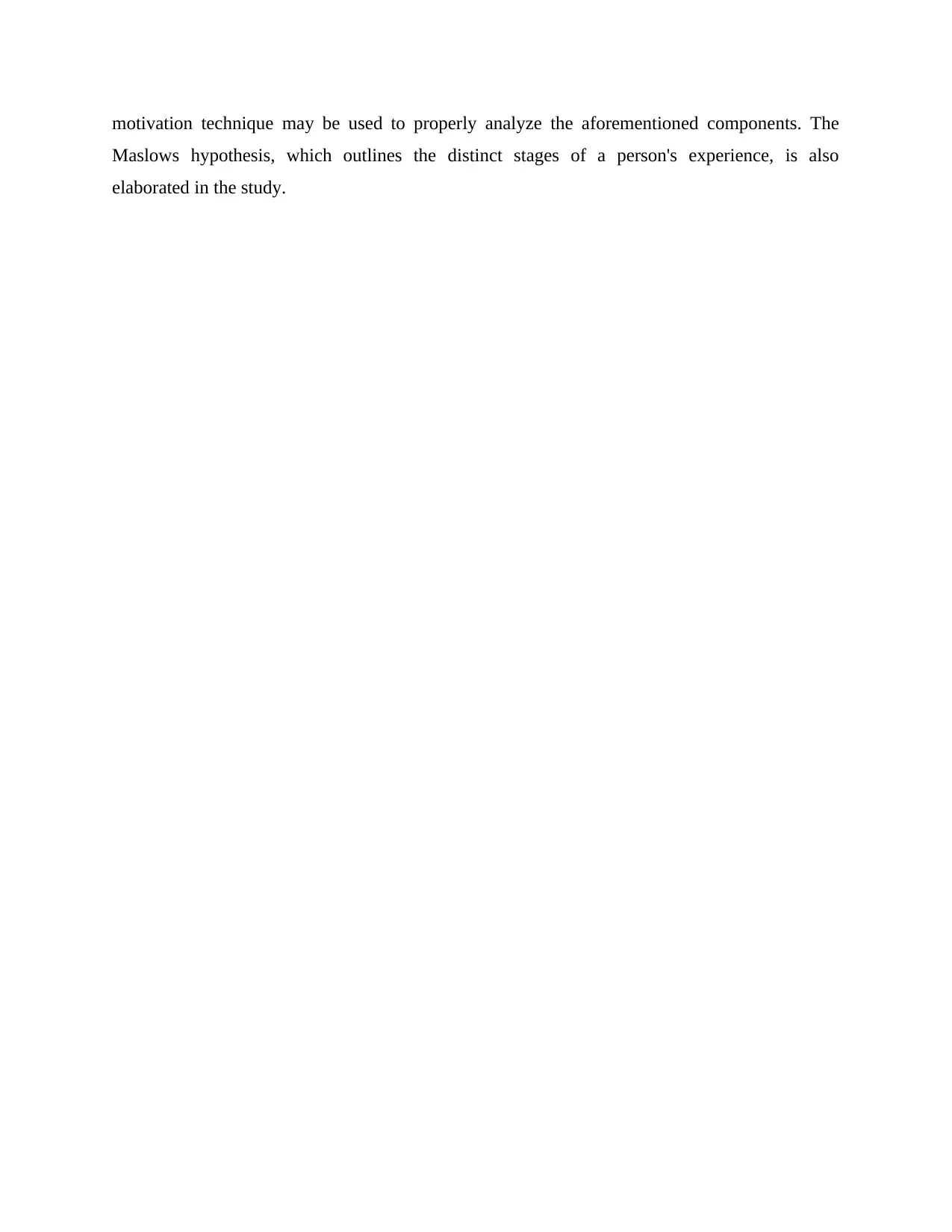
motivation technique may be used to properly analyze the aforementioned components. The
Maslows hypothesis, which outlines the distinct stages of a person's experience, is also
elaborated in the study.
Maslows hypothesis, which outlines the distinct stages of a person's experience, is also
elaborated in the study.
⊘ This is a preview!⊘
Do you want full access?
Subscribe today to unlock all pages.

Trusted by 1+ million students worldwide
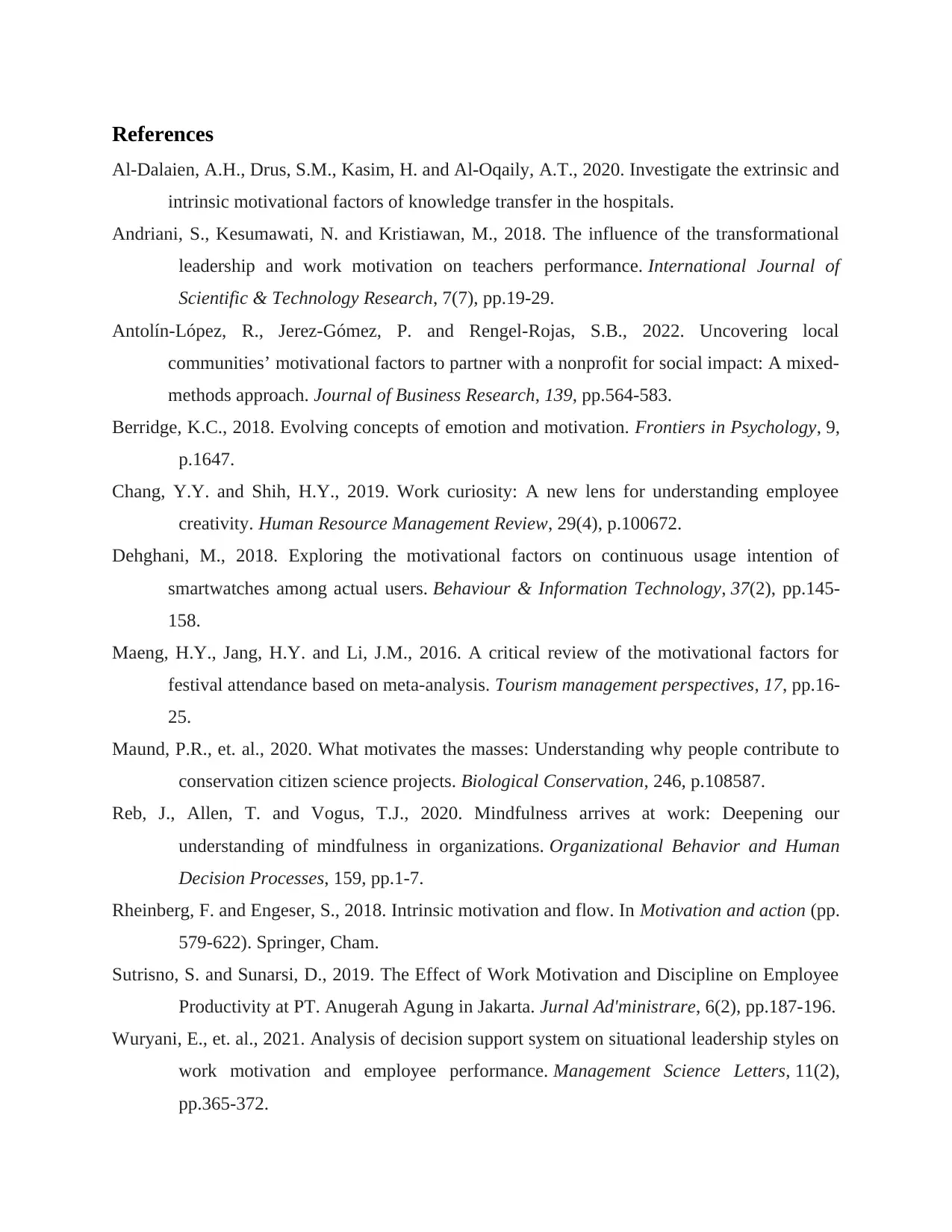
References
Al-Dalaien, A.H., Drus, S.M., Kasim, H. and Al-Oqaily, A.T., 2020. Investigate the extrinsic and
intrinsic motivational factors of knowledge transfer in the hospitals.
Andriani, S., Kesumawati, N. and Kristiawan, M., 2018. The influence of the transformational
leadership and work motivation on teachers performance. International Journal of
Scientific & Technology Research, 7(7), pp.19-29.
Antolín-López, R., Jerez-Gómez, P. and Rengel-Rojas, S.B., 2022. Uncovering local
communities’ motivational factors to partner with a nonprofit for social impact: A mixed-
methods approach. Journal of Business Research, 139, pp.564-583.
Berridge, K.C., 2018. Evolving concepts of emotion and motivation. Frontiers in Psychology, 9,
p.1647.
Chang, Y.Y. and Shih, H.Y., 2019. Work curiosity: A new lens for understanding employee
creativity. Human Resource Management Review, 29(4), p.100672.
Dehghani, M., 2018. Exploring the motivational factors on continuous usage intention of
smartwatches among actual users. Behaviour & Information Technology, 37(2), pp.145-
158.
Maeng, H.Y., Jang, H.Y. and Li, J.M., 2016. A critical review of the motivational factors for
festival attendance based on meta-analysis. Tourism management perspectives, 17, pp.16-
25.
Maund, P.R., et. al., 2020. What motivates the masses: Understanding why people contribute to
conservation citizen science projects. Biological Conservation, 246, p.108587.
Reb, J., Allen, T. and Vogus, T.J., 2020. Mindfulness arrives at work: Deepening our
understanding of mindfulness in organizations. Organizational Behavior and Human
Decision Processes, 159, pp.1-7.
Rheinberg, F. and Engeser, S., 2018. Intrinsic motivation and flow. In Motivation and action (pp.
579-622). Springer, Cham.
Sutrisno, S. and Sunarsi, D., 2019. The Effect of Work Motivation and Discipline on Employee
Productivity at PT. Anugerah Agung in Jakarta. Jurnal Ad'ministrare, 6(2), pp.187-196.
Wuryani, E., et. al., 2021. Analysis of decision support system on situational leadership styles on
work motivation and employee performance. Management Science Letters, 11(2),
pp.365-372.
Al-Dalaien, A.H., Drus, S.M., Kasim, H. and Al-Oqaily, A.T., 2020. Investigate the extrinsic and
intrinsic motivational factors of knowledge transfer in the hospitals.
Andriani, S., Kesumawati, N. and Kristiawan, M., 2018. The influence of the transformational
leadership and work motivation on teachers performance. International Journal of
Scientific & Technology Research, 7(7), pp.19-29.
Antolín-López, R., Jerez-Gómez, P. and Rengel-Rojas, S.B., 2022. Uncovering local
communities’ motivational factors to partner with a nonprofit for social impact: A mixed-
methods approach. Journal of Business Research, 139, pp.564-583.
Berridge, K.C., 2018. Evolving concepts of emotion and motivation. Frontiers in Psychology, 9,
p.1647.
Chang, Y.Y. and Shih, H.Y., 2019. Work curiosity: A new lens for understanding employee
creativity. Human Resource Management Review, 29(4), p.100672.
Dehghani, M., 2018. Exploring the motivational factors on continuous usage intention of
smartwatches among actual users. Behaviour & Information Technology, 37(2), pp.145-
158.
Maeng, H.Y., Jang, H.Y. and Li, J.M., 2016. A critical review of the motivational factors for
festival attendance based on meta-analysis. Tourism management perspectives, 17, pp.16-
25.
Maund, P.R., et. al., 2020. What motivates the masses: Understanding why people contribute to
conservation citizen science projects. Biological Conservation, 246, p.108587.
Reb, J., Allen, T. and Vogus, T.J., 2020. Mindfulness arrives at work: Deepening our
understanding of mindfulness in organizations. Organizational Behavior and Human
Decision Processes, 159, pp.1-7.
Rheinberg, F. and Engeser, S., 2018. Intrinsic motivation and flow. In Motivation and action (pp.
579-622). Springer, Cham.
Sutrisno, S. and Sunarsi, D., 2019. The Effect of Work Motivation and Discipline on Employee
Productivity at PT. Anugerah Agung in Jakarta. Jurnal Ad'ministrare, 6(2), pp.187-196.
Wuryani, E., et. al., 2021. Analysis of decision support system on situational leadership styles on
work motivation and employee performance. Management Science Letters, 11(2),
pp.365-372.
Paraphrase This Document
Need a fresh take? Get an instant paraphrase of this document with our AI Paraphraser

1 out of 11
Related Documents
Your All-in-One AI-Powered Toolkit for Academic Success.
+13062052269
info@desklib.com
Available 24*7 on WhatsApp / Email
![[object Object]](/_next/static/media/star-bottom.7253800d.svg)
Unlock your academic potential
Copyright © 2020–2025 A2Z Services. All Rights Reserved. Developed and managed by ZUCOL.



